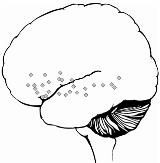INTRAHEMISPHERIC REORGANIZATION OF LANGUAGE IN EARLY ONSET EPILEPSY
Abstract number :
2.483
Submission category :
Year :
2004
Submission ID :
4932
Source :
www.aesnet.org
Presentation date :
12/2/2004 12:00:00 AM
Published date :
Dec 1, 2004, 06:00 AM
Authors :
1,2D. S. Kadis, 1,2,3M.L. Smith, 2A. Crawley, 2,3I. Elliott, 3K. Iida, 1E. Kerr, 2,3W. Logan, 2,5M.P. McAndrews, 3A. Ochi, 3H. Otsubo, 2,4</
Study of individuals with epilepsy suggests a period of increased functional plasticity of language within the first few years of life, in that those with early seizure onset demonstrate increased right- and bilateral language representation. Historically, research has focused on [italic]inter[/italic]hemispheric shifts in language representation, without systematically assessing [italic]intra[/italic]hemispheric effects. In this study, we developed a novel 2D-to-3D coregistration technique to assess findings from invasive language mappings. This study is the first to investigate the extent of intrahemispheric reorganization in the context of paediatric epilepsy. Eight children, aged 5.7-17.8 years underwent extraoperative stimulation mapping (ESM) to localize language within the left hemisphere. All had left-hemisphere seizure foci with onset before 6 years. ESM permitted direct cortical stimulation and precise determination of language areas using subdural grids. Capture of digital images at the time of implant facilitated development of detailed functional maps, sensitive to each patient[rsquo]s unique cortical morphology. ESM data were co-registered with 3D brain representations compiled from thin-slice MRIs, spatially normalized, and assessed in standard stereotactic space. Language sites were compared to structural probability maps of the frontal operculum, or Broca[rsquo]s area. Language areas were observed both within and outside of canonical language regions (Broca[rsquo]s area and Wernicke[rsquo]s area; see [italic]Figure[/italic]). In the frontal lobe, language sites were observed in regions substantially anterior and superior to classical Broca[rsquo]s area, to an extent not previously described. Language sites were observed inside, bordering, and outside of epileptogenic regions. [figure1] In addition to [italic]inter[/italic]hemispheric shifts in language, individuals with early onset epilepsy experience [italic]intra[/italic]hemispheric reorganization of language. Neurosurgical teams must consider the potential for language representation anterior to Broca[rsquo]s area; abnormal cortex may support language. Extensive functional mapping within and beyond canonical language areas is necessary for comprehensive characterization of the language cortex.
